Gujarat Board GSEB Textbook Solutions Class 6 Maths Chapter 14 Practical Geometry Ex 14.5 Textbook Questions and Answers.
Gujarat Board Textbook Solutions Class 6 Maths Chapter 14 Practical Geometry Ex 14.5
Question 1.
Draw \(\overline{\mathrm{AB}}\) of length 7.3 cm and find its axis of symmetry.
Note: The perpendicular bisector of a line segment is its axis of symmetry.
Solution:
Steps of construction:
Step I: Draw line segment \(\overline{\mathrm{AB}}\) = 7.3 cm.
Step II: With centres A and B and radius more than half of AB, draw two arcs that intersect each other at P and Q.
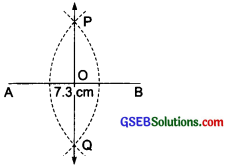
Step III: Join P and Q.
Thus, PQ is the axis of symmetry of \(\overline{\mathrm{AB}}\).
Question 2.
Draw a line segment of length 9.5 cm and construct its perpendicular bisector.
Solution:
Steps of construction:
Step I: Draw a line segment AB = 9.5 cm.
Step II: With A and B as centres and radius more than half of \(\overline{\mathrm{AB}}\), draw two arcs on either side of AB which intersects each other at P and Q.
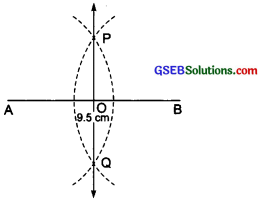
Step III: Join P and Q.
Thus, PQ is the required perpendicular bisector of \(\overline{\mathrm{AB}}\).
![]()
Question 3.
Draw the perpendicular bisector of \(\overline{\mathrm{XY}}\) whose length is 10.3 cm.
(a) Take any point P on the bisector drawn. Examine whether PX = PY.
(b) If M is the mid-point of \(\overline{\mathrm{XY}}\), what can you say about the lengths MX and XY?
Solution:
Steps of construction:
Step I: Draw a line segment \(\overline{\mathrm{XY}}\) = 10.3 cm
Step II: With X and Y as centres and radius more than half of XY, draw two arcs on either side of XY which intersect each other at A and B.
Step III: join A and B.
Thus, AB is ⊥ \(\overline{\mathrm{XY}}\)

Step IV: Mark a point ‘P’ on AB and join PX and PY.
(a) On measuring \(\overline{\mathrm{PX}}\) and \(\overline{\mathrm{PY}}\) (using a divider) we get that \(\overline{\mathrm{PX}}\) = \(\overline{\mathrm{PY}}\) .
(b) The mid-point of XY is M. On measuring,
we have that \(\overline{\mathrm{XM}}\) = \(\overline{\mathrm{MY}}\) = \(\frac { 1 }{ 2 }\) XY.
Question 4.
Draw a line segment of length 12.8 cm. Using compasses, divide it into four equal parts. Verify by actual measurement.
Solution:
Steps of construction:
Step I: Draw a line segment \(\overline{\mathrm{AB}}\) = 12.8 cm.

Step II: Draw perpendicular bisector of AB, which meets \(\overline{\mathrm{AB}}\) at O. (i.e. O is the mid-point of \(\overline{\mathrm{AB}}\))
Step III: Draw perpendicular bisector of \(\overline{\mathrm{AO}}\), which meet \(\overline{\mathrm{AB}}\) at P. {i.e. P is mid-point of \(\overline{\mathrm{AO}}\))
Step IV: Now, draw perpendicular bisector of \(\overline{\mathrm{BO}}\), which meets AB at Q. (i.e. Q is the mid-point of OB)
Step V: The line segment is divided into 4 equal parts by the points P, 0 and Q.
Step VI: By actual measurement, we have:
\(\overline{\mathrm{AP}}\) = \(\overline{\mathrm{PO}}\) = \(\overline{\mathrm{OQ}}\) = \(\overline{\mathrm{QB}}\) = 3.2 cm
![]()
Question 5.
With \(\overline{\mathrm{PQ}}\) of length 6.1 cm as diameter, draw a circle.
Solution:
Steps of construction:
Step I: Draw a line segment \(\overline{\mathrm{XY}}\) =6.1 cm.
Step II: Draw the perpendicular bisector of PQ which meets \(\overline{\mathrm{XY}}\) at O. (i.e. O is the mid-point of PQ).

Step III: With centre O and \(\overline{\mathrm{OP}}\) or \(\overline{\mathrm{OQ}}\) as radius, draw a circle passing through P and Q.
The circle having \(\overline{\mathrm{XY}}\) as the diameter is the required circle.
Question 6.
Draw a circle with centre C and radius 3.4 cm. Draw any chord \(\overline{\mathrm{AB}}\).Construct the perpendicular bisector of \(\overline{\mathrm{AB}}\) and examine if it passes through C.
Solution:
Steps of construction:
Step I: Mark a point C on a paper.
Step II: With centre ‘C’ and radius 3.4 cm, draw a circle.
Step III: Draw a chord \(\overline{\mathrm{AB}}\).
Step IV: Draw perpendicular bisector of \(\overline{\mathrm{AB}}\).
We find that l (the perpendicular bisector of \(\overline{\mathrm{AB}}\)) passes through the centre of the circle.

Question 7.
Repeat question 6, if \(\overline{\mathrm{AB}}\) happens to be a diameter.
Solution:
Steps of construction:
Step I: Mark a point ‘C’ on a paper.
Step II: With centre C and radius 3.4 cm, draw a circle.
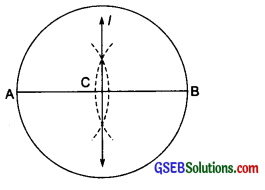
Step III: Draw a diameter \(\overline{\mathrm{AB}}\) of the circle.
Step IV: Draw the perpendicular bisector ‘l’ of \(\overline{\mathrm{AB}}\). We find that l passes through C and C is the mid-point of AB.
![]()
Question 8.
Draw a circle of radius 4 cm. Draw any two of its chords. Construct the perpendicular bisectors of these chords. Where do they meet?
Solution:
Steps of construction:
Step I: Mark a point O on a paper.
Step II: With centre O and radius 4 cm, draw a circle.
Step III: Draw two chords \(\overline{\mathrm{AB}}\) and \(\overline{\mathrm{CD}}\).
Step IV: Draw perpendicular bisector ‘l’ of \(\overline{\mathrm{AB}}\).
Step V: Draw perpendicular bisector ‘M’ of \(\overline{\mathrm{CD}}\).
Step VI: Produce l and m to meet each other. We find that l and m meet at O, the centre of the circle.
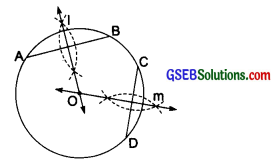
Question 9.
Draw any angle with vertex O. Take a point A on one of its arms and B on another such that OA = OB. Draw the perpendicular bisectors of \(\overline{\mathrm{OA}}\) and \(\overline{\mathrm{OB}}\). Let them meet at P. Is PA = PB?
Solution:
Steps of construction:
Step I: Mark a point O on a paper.
Step II: Draw an angle ∠XOY, having a vertex at O.
Step III: Mark a point A on \(\overrightarrow{\mathrm{OX}}\) and another point B on \(\overrightarrow{\mathrm{OY}}\), such that \(\overline{\mathrm{OA}}\) = \(\overline{\mathrm{OB}}\).
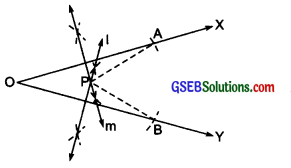
Step IV: Draw l, the perpendicular bisector of \(\overline{\mathrm{OB}}\) .
Step V: Draw m, the perpendicular bisector of \(\overline{\mathrm{OA}}\)
Step VI: Mark the intersecting points of l and m as P.
Step VII: Join \(\overline{\mathrm{PA}}\) and \(\overline{\mathrm{PB}}\), measure them with the help of a divider.
Step VIII: On measuring, we find \(\overline{\mathrm{PA}}\) = \(\overline{\mathrm{PB}}\)